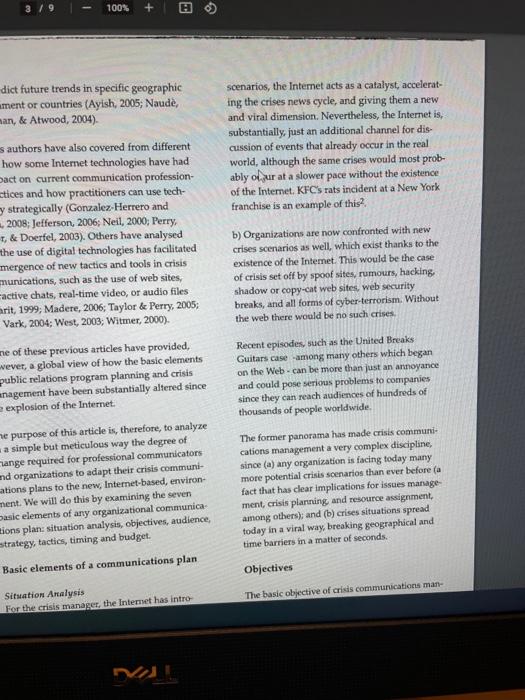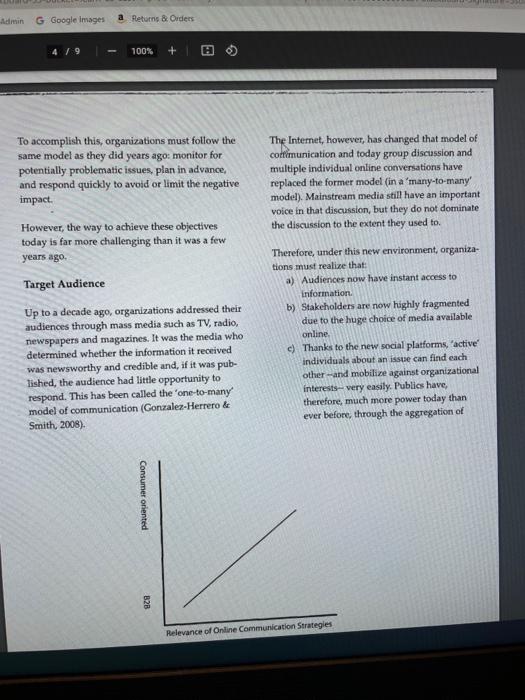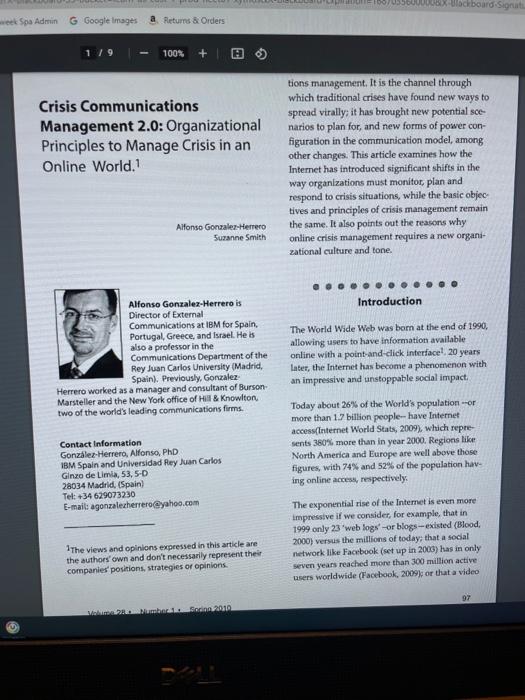
please read and react 1 page. what do you agree and or disagree with
To accomplish this, organizations must follow the same model as they did years ago: monitor for potentially problematic issues, plan in advance, and respond quickly to avoid or limit the negative impact. However, the way to achieve these objectives today is far more challenging than it was a few years ago, Target Audience Up to a decade ago, organizations addressed their audiences through mass media such as TV, radio, newspapers and magazines. It was the media who determined whether the information it received was newsworthy and credible and, if it was published, the audience had little opportunity to respond. This has been called the 'one-to-many' model of communication (Gonzalez-Herrero \& Smith, 2008). The Internet, however, has changed that model of cottimunication and today group discussion and multiple individual online conversations have replaced the former model (in a 'many-to-many' model). Mainstream media still have an important voice in that discussion, but they do not dominate the discussion to the extent they used to. Therefore, under this new environment, organizations must realize that: a) Audiences now have instant access to information: b) Stakeholders are now highly fragmented due to the huge choice of media available online. c) Thanks to the new social platforms, 'active' individuals about an issue can find each other-and mobilize against organizational interests-very easily. Publics have, therefore, much more power today than ever before, through the aggregation of dict future trends in specific geographic ment or countries (Ayish, 2005; Naude, an, \& Atwood, 2004). 5 authors have also covered from different how some Internet technologies have had oact on current communication professiontices and how practitioners can use techy strategically (Gonzalez-Herrero and 2008; Jefferson, 2006; Neil, 2000; Perry. t, \& Doerfel, 2003). Others have analysed the use of digital technologies has facilitated mergence of new tactics and tools in crisis munications, such as the use of web sites, active chats, real-time video, or audio files rit, 1999; Madere, 2006; Taylor \& Perry. 2005; Vark, 2004; West, 2003; Witmer, 2000). ef these previous articles have provided, vever, a global view of how the basic elements aublic relations program planning and crisis nagement have been substantially altered since explosion of the Internet. we purpose of this article is, therefore, to analyze a simple but meticulous way the degree of ange required for professional communicators nd organizations to adapt their crisis communiations plans to the new, Internet-based, environnent. We will do this by examining the seven oasic elements of any organizational communicaions plan: situation analysis, objectives, audience, strategy, tactics, timing and budget. Basic elements of a communications plan Situation Aralysis scenarios, the Internet acts as a catalyst, accelerating the crises news cycle, and giving them a new and viral dimension. Nevertheless, the lnternet is, substantially, just an additional channel for discussion of events that already occur in the real world, although the same crises would most probably offur at a slower pace without the existence of the Internet, KFC's rats incident at a New York franchise is an example of this? b) Organizations are now confronted with new crises scenarios as well, which exist thanks to the existence of the Intemet. This would be the case of crisis set off by spoof sites, rumours, hacking, shadow or copy-cat web sites, web security breaks, and all forms of cyber-terrorism. Without the web there would be no such crises. Recent episodes, such as the United Breaks Guitars case -among many others which began on the Web - can be more than just an arnoyance and could pose serious problems to companies since they can reach audiences of hundreds of thousands of people worldwide. The former panorama has made crisis communications management a very complex discipline, since (a) any organization is facing today many more potential crisis soenarios than ever before (a fact that has clear implications for issues management, crisis plarning and resource assignment, anong others); and (b) crises situations spread today in a viral way, breaking geographical and time barriers in a matter of seconds. Objectives The basic objective of crisis communications man- 2009) and serves more than one billion videos worldwide daily (Wikipedia, 2009). These numbers cannot be ignored by communications pro- Suranne Smith is EMEA Senior Consultant at Text 100, Madrid based. She has over 14 years of international communications consultancy expertence. Suzanne S mith is the founder of Text 100's Madrid office, which she ran successfully for eight years, building the business into one of the most respected agencies in Spain. In her current role of EMEA Senior Consultant Suzanne advises a range of Text 100 's European clients on their PR and communications programs. Contact Information Smith, Suzanne Senior Consultant, Text 100 EMEA, Plaza de Colbn, 2, Torre 1 - Planta 17 28046 Madrid (Spain) Tet +34629522435 E-mail: suzannesmithetext100.es fessionals. Organizational communication and online crisis management In our hectic world, news literally jumps -through If screens, mobile devices, or digital TV sets-- from one spot of the World to another in a matter of seconds. The Internet has become the preferred platform of information and communication for many customers, investors, analysts, employees, the media, and the many other stakeholders any company has, transforming the practice of organizational communications as a whole. Organizational crises have found today new ways to spread. Like viruses, they now mutate, acquiring new and dangerous forms in, for example, social forums like Facebook, or video distribution sites such as Youtube. And, while communications professionals feel confident about how to prevent and treat crisis in the 'real' world, many of them are simply bewildered when faced with the implications of such crises in the 'virtual' side of business. Literature review The impact of the Internet on organizational communication has been a topic of great attention in recent years. Kent, Taylor, and White (2003) and Settles (1996), for example, have studied the organizational responsiveness to stakeholders. Others have tried to establish leading edge use of such technologies (Gonzalez-Herrero, Ruiz de Valbuena, \& Ruiz San Romain, 2005; Ha \& Pratt 2000; Taylor, Kent, \& White, 2001), or to analyze tions management. It is the channel through Crisis Communications Management 2.0: Organizational Principles to Manage Crisis in an Online World.' Alfonso Gonzalez Herrero suranne Smith Alfonso Gonxalex-Herrero is Director of Extemal Communications at IBM for Spain, Portugal, Greece, and isrsel. He is also a profesvor in the Communications Department of the Rey Juan Carlos University (Madrid, Spain). Previously, Gonalez. Herrero worked as a manager and consultant of BursonMarsteller and the New York office of Hili \& Knowiton, Marstellef and the New York office of Hicas knowitons. Contact Information GonzleztHerrero, Alfonso, PhD IBMSpain and Universidad Rey Juan Carlos Ginzo de Limia, 53,5-D 28034 Madrid, (Spain) Tet: +34629073230 E-maili agonzalecherrero@yahoo.com The views and opinions expeessed in this article are the authors' ewn and don't necessarly represent theit companies posirions, strategies or opinions. which traditional crises have found new ways to spread virally; it has brought new potential scenarios to plan for, and new forms of power configuration in the communication model, among other changes. This article examines how the Internet has introduced significant shifts in the way organizations must monitor, plan and respond to crisis situations, while the basic objectives and principles of crisis management remain the same. It also points out the reasons why online crisis management requires a new organdzational culture and tone. Introduction The World Wide Web was bom at the end of 1990 , allowing users to have information available online with a point-and-click interface 1,20 years later, the Intemet has become a phenomenon with an impressive and unstoppable sodal impact. Today about 26% of the World's population -or more than 17 billion people- have Internet accessfaternet World Stats, 2009), which represents 360% more than in year 2000 . Regions like North America and Europe are well above those figures, with 74% and 52% of the popalation having online acxess, mpectively. The expontential rise of the Intemet is even more impressive if we consider, for example, that in 1999 only 23 'web hogs' -or blogs - existed (Blood, 2000) versus the millions of today; that a soclal 2000) versus the milisons of today, that a sodial seven years reathed more than 300 millien active users worldwide (Facebook, 2009) or that a video To accomplish this, organizations must follow the same model as they did years ago: monitor for potentially problematic issues, plan in advance, and respond quickly to avoid or limit the negative impact. However, the way to achieve these objectives today is far more challenging than it was a few years ago, Target Audience Up to a decade ago, organizations addressed their audiences through mass media such as TV, radio, newspapers and magazines. It was the media who determined whether the information it received was newsworthy and credible and, if it was published, the audience had little opportunity to respond. This has been called the 'one-to-many' model of communication (Gonzalez-Herrero \& Smith, 2008). The Internet, however, has changed that model of cottimunication and today group discussion and multiple individual online conversations have replaced the former model (in a 'many-to-many' model). Mainstream media still have an important voice in that discussion, but they do not dominate the discussion to the extent they used to. Therefore, under this new environment, organizations must realize that: a) Audiences now have instant access to information: b) Stakeholders are now highly fragmented due to the huge choice of media available online. c) Thanks to the new social platforms, 'active' individuals about an issue can find each other-and mobilize against organizational interests-very easily. Publics have, therefore, much more power today than ever before, through the aggregation of dict future trends in specific geographic ment or countries (Ayish, 2005; Naude, an, \& Atwood, 2004). 5 authors have also covered from different how some Internet technologies have had oact on current communication professiontices and how practitioners can use techy strategically (Gonzalez-Herrero and 2008; Jefferson, 2006; Neil, 2000; Perry. t, \& Doerfel, 2003). Others have analysed the use of digital technologies has facilitated mergence of new tactics and tools in crisis munications, such as the use of web sites, active chats, real-time video, or audio files rit, 1999; Madere, 2006; Taylor \& Perry. 2005; Vark, 2004; West, 2003; Witmer, 2000). ef these previous articles have provided, vever, a global view of how the basic elements aublic relations program planning and crisis nagement have been substantially altered since explosion of the Internet. we purpose of this article is, therefore, to analyze a simple but meticulous way the degree of ange required for professional communicators nd organizations to adapt their crisis communiations plans to the new, Internet-based, environnent. We will do this by examining the seven oasic elements of any organizational communicaions plan: situation analysis, objectives, audience, strategy, tactics, timing and budget. Basic elements of a communications plan Situation Aralysis scenarios, the Internet acts as a catalyst, accelerating the crises news cycle, and giving them a new and viral dimension. Nevertheless, the lnternet is, substantially, just an additional channel for discussion of events that already occur in the real world, although the same crises would most probably offur at a slower pace without the existence of the Internet, KFC's rats incident at a New York franchise is an example of this? b) Organizations are now confronted with new crises scenarios as well, which exist thanks to the existence of the Intemet. This would be the case of crisis set off by spoof sites, rumours, hacking, shadow or copy-cat web sites, web security breaks, and all forms of cyber-terrorism. Without the web there would be no such crises. Recent episodes, such as the United Breaks Guitars case -among many others which began on the Web - can be more than just an arnoyance and could pose serious problems to companies since they can reach audiences of hundreds of thousands of people worldwide. The former panorama has made crisis communications management a very complex discipline, since (a) any organization is facing today many more potential crisis soenarios than ever before (a fact that has clear implications for issues management, crisis plarning and resource assignment, anong others); and (b) crises situations spread today in a viral way, breaking geographical and time barriers in a matter of seconds. Objectives The basic objective of crisis communications man- 2009) and serves more than one billion videos worldwide daily (Wikipedia, 2009). These numbers cannot be ignored by communications pro- Suranne Smith is EMEA Senior Consultant at Text 100, Madrid based. She has over 14 years of international communications consultancy expertence. Suzanne S mith is the founder of Text 100's Madrid office, which she ran successfully for eight years, building the business into one of the most respected agencies in Spain. In her current role of EMEA Senior Consultant Suzanne advises a range of Text 100 's European clients on their PR and communications programs. Contact Information Smith, Suzanne Senior Consultant, Text 100 EMEA, Plaza de Colbn, 2, Torre 1 - Planta 17 28046 Madrid (Spain) Tet +34629522435 E-mail: suzannesmithetext100.es fessionals. Organizational communication and online crisis management In our hectic world, news literally jumps -through If screens, mobile devices, or digital TV sets-- from one spot of the World to another in a matter of seconds. The Internet has become the preferred platform of information and communication for many customers, investors, analysts, employees, the media, and the many other stakeholders any company has, transforming the practice of organizational communications as a whole. Organizational crises have found today new ways to spread. Like viruses, they now mutate, acquiring new and dangerous forms in, for example, social forums like Facebook, or video distribution sites such as Youtube. And, while communications professionals feel confident about how to prevent and treat crisis in the 'real' world, many of them are simply bewildered when faced with the implications of such crises in the 'virtual' side of business. Literature review The impact of the Internet on organizational communication has been a topic of great attention in recent years. Kent, Taylor, and White (2003) and Settles (1996), for example, have studied the organizational responsiveness to stakeholders. Others have tried to establish leading edge use of such technologies (Gonzalez-Herrero, Ruiz de Valbuena, \& Ruiz San Romain, 2005; Ha \& Pratt 2000; Taylor, Kent, \& White, 2001), or to analyze tions management. It is the channel through Crisis Communications Management 2.0: Organizational Principles to Manage Crisis in an Online World.' Alfonso Gonzalez Herrero suranne Smith Alfonso Gonxalex-Herrero is Director of Extemal Communications at IBM for Spain, Portugal, Greece, and isrsel. He is also a profesvor in the Communications Department of the Rey Juan Carlos University (Madrid, Spain). Previously, Gonalez. Herrero worked as a manager and consultant of BursonMarsteller and the New York office of Hili \& Knowiton, Marstellef and the New York office of Hicas knowitons. Contact Information GonzleztHerrero, Alfonso, PhD IBMSpain and Universidad Rey Juan Carlos Ginzo de Limia, 53,5-D 28034 Madrid, (Spain) Tet: +34629073230 E-maili agonzalecherrero@yahoo.com The views and opinions expeessed in this article are the authors' ewn and don't necessarly represent theit companies posirions, strategies or opinions. which traditional crises have found new ways to spread virally; it has brought new potential scenarios to plan for, and new forms of power configuration in the communication model, among other changes. This article examines how the Internet has introduced significant shifts in the way organizations must monitor, plan and respond to crisis situations, while the basic objectives and principles of crisis management remain the same. It also points out the reasons why online crisis management requires a new organdzational culture and tone. Introduction The World Wide Web was bom at the end of 1990 , allowing users to have information available online with a point-and-click interface 1,20 years later, the Intemet has become a phenomenon with an impressive and unstoppable sodal impact. Today about 26% of the World's population -or more than 17 billion people- have Internet accessfaternet World Stats, 2009), which represents 360% more than in year 2000 . Regions like North America and Europe are well above those figures, with 74% and 52% of the popalation having online acxess, mpectively. The expontential rise of the Intemet is even more impressive if we consider, for example, that in 1999 only 23 'web hogs' -or blogs - existed (Blood, 2000) versus the millions of today; that a soclal 2000) versus the milisons of today, that a sodial seven years reathed more than 300 millien active users worldwide (Facebook, 2009) or that a video

 please read and react 1 page. what do you agree and or disagree with
please read and react 1 page. what do you agree and or disagree with







